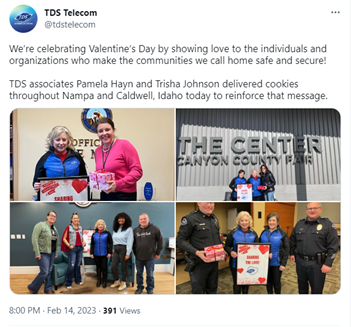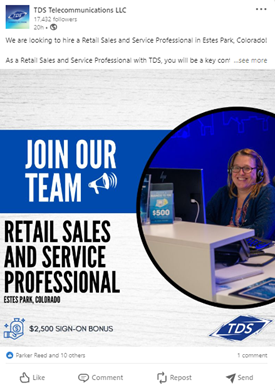With nearly 4.8 billion social media users worldwide, 60% of the world’s population are constantly scrolling, posting, tweeting—and shopping—on social media.
There’s no denying the rise of social media has transformed many aspects of business in the last 20 years. For small and medium business owners, one of the most noteworthy shifts has been changes in shopper behavior. In fact, a 2021 Forbes research study revealed that two-thirds of shoppers today use social media as part of their shopping strategy.
Cultivating a strong social media presence is crucial for driving new business. When executed correctly, social media helps your business in countless ways—improving your customer service, allowing convenient communication with customers, helping you reach new audiences, establish brand awareness, boost conversations surrounding your business, and driving traffic to your website.
Before developing your social media strategy, let’s take a closer look at four of the most important social media and networking services to consider for your business.
- With over 2.91 billion users, Facebook is the biggest social media platform in terms of user base.
- Facebook has the largest share of adult users at 74.2%.

- Facebook is the most popular social network for men and women aged 35-44
- About 49% of Americans say they visit Facebook several times per day.
Facebook’s many free features are beneficial to small and medium businesses. For starters, you can create an appealing business page to directly connect with customers through the Facebook Messenger feature. Facebook’s Marketplace, used by 800 million people each month, is free for all businesses to use for listing and managing products.
Businesses who use Messenger can interact with, provide support to, and send frequent updates to customers. On the business page, prospects can find other crucial information like the store address, phone number, hours of operation, product offerings, and upcoming events. Facebook also allows you to promote content by sharing posts, media, and upcoming events on both your feed and in your daily stories.
Creating a business Facebook page allows you to:
- List basic information.
- Engage new and old customers.
- Learn your audience.
- Reduce marketing costs.
- Boost web traffic.
- Improve SEO.
For help creating your own Facebook business page, browse this link from Meta’s Business Help Center. Facebook changed its name to Meta to separate its work on new technologies from the Facebook social media platform.
- Gen Z’s favorite social platform, nearly 62% of Instagram users are ages 18-34.
- Instagram is the fourth most-visited social platform in the U.S.
- Only one-in-10 U.S. adults regularly get their current events from the Instagram.
The second-most downloaded smartphone app in the world, Instagram is a visual social media platform with a heavy emphasis on photo and video content. While the visual nature can make it difficult to use for brands without a tangible product, b
ut just about every business can benefit from using it.
That’s because of the app’s user behavior: Instagram users like to connect with brands. Much like Facebook, Instagram is a great option to promote your products and services, and boost your brand image. Followers can view bright and vibrant photos of your brand as they scroll through their feed, accompanied by captions, tags, and hashtags. Products in posts can be tagged, allowing for a direct link back to the store location or website for purchase.
For inspiration on starting your own Instagram account, scroll through this article for some advice and best practices.
- Twitter is the world’s 15th most-used social media platform.
- Twitter is the most popular social media source for news in the U.S.
- Most Twitter users are between the ages of 25 and 34, and the app has a small age gap in active users.
- 80% of Twitter usage is carried out on smartphones.
Twitter is known for its tweets—microblog posts with a 280-character limit where users can briefly say what’s on their mind. Twitter is heavily based on information and text. While you can still share photos, GIFs, and videos to enhance your tweets, in contrast to Instagram, the focus is very much on the written word.
Tweets are a great way for small businesses to create a consistent voice that aligns with their values, engages with potential customers, and reaches a particular demographic. Posting tweets to your business’ feed gives you a chance to interact with customers who have mentioned your business on their personal page. Twitter can also track your analytics, so your company is able to see what’s engaging and what isn’t.
Twitter has a great blog for business account set-up and best practices, and it, and another outlining all the benefits the platform can offer your business.
LinkedIn
- LinkedIn has 810 million members.
- Almost 60% of LinkedIn’s users are between 25 and 34 years old.
- Six people are hired through LinkedIn every minute.
If it’s your goal to market to professionals and potential employees, there’s no better place than LinkedIn. The world’s largest professional network allows companies to showcase the products and services they provide directly on their business profile, giving viewers an immediate idea of what your business has to offer. It also allows you to build credibility, establish industry authority, and create a meaningful network.
Platform users connect with like-minded professionals, apply and recruit for jobs, and follow the latest news and industry trends from influential organizations and professionals throughout the world. In the platform’s “About” section, you can showcase the voice behind your brand. You can even post customers’ past reviews of your business’ products or services to your profile for free advertising.
Checkout Hootsuite’s comprehensive guide to learn how to effectively use LinkedIn for business.

No comments yet.